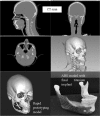Design and 3D-printing of titanium bone implants: brief review of approach and clinical cases
- PMID: 30603218
- PMCID: PMC6209081
- DOI: 10.1007/s13534-018-0080-5
Design and 3D-printing of titanium bone implants: brief review of approach and clinical cases
Abstract
Additive manufacturing (AM) is an alternative metal fabrication technology. The outstanding advantage of AM (3D-printing, direct manufacturing), is the ability to form shapes that cannot be formed with any other traditional technology. 3D-printing began as a new method of prototyping in plastics. Nowadays, AM in metals allows to realize not only net-shape geometry, but also high fatigue strength and corrosion resistant parts. This success of AM in metals enables new applications of the technology in important fields, such as production of medical implants. The 3D-printing of medical implants is an extremely rapidly developing application. The success of this development lies in the fact that patient-specific implants can promote patient recovery, as often it is the only alternative to amputation. The production of AM implants provides a relatively fast and effective solution for complex surgical cases. However, there are still numerous challenging open issues in medical 3D-printing. The goal of the current research review is to explain the whole technological and design chain of bio-medical bone implant production from the computed tomography that is performed by the surgeon, to conversion to a computer aided drawing file, to production of implants, including the necessary post-processing procedures and certification. The current work presents examples that were produced by joint work of Polygon Medical Engineering, Russia and by TechMed, the AM Center of Israel Institute of Metals. Polygon provided 3D-planning and 3D-modelling specifically for the implants production. TechMed were in charge of the optimization of models and they manufactured the implants by Electron-Beam Melting (EBM®), using an Arcam EBM® A2X machine.
Keywords: 3D-printing; Additive manufacturing; Bio-medical implants; CAD design; Computed tomography; Electron beam melting; Ti–6Al–4V.
Conflict of interest statement
The authors declare that they have no conflict of interest.Ethical approval was obtained in Russia according to the local guidelines.
Figures










References
-
- Official web-site of Arcam EBM® AB, machines manufacturer. http://www.arcam.com. Accessed July 2018.
-
- Kamsky GV, Kolomiets AA, Popov VV. Review of the main producers of 3D-machines for metals, characteristics of the machines, and directions of development. Res J Int Stud. 2016;8(50): ISSN 2227-6017.
-
- ASTM WK30522: New specification for additive manufacturing Titanium–6 Aluminum–4Vanadium with powder bed process. http://www.astm.org/DATABASE.CART/WORKITEMS/WK30522.htm. Accessed 2018.
-
- Woo DG, Kim CH, Kim HS, Lim D. An experimental–numerical methodology for a rapid prototyped application combined with finite element models in vertebral trabecular bone. Exp Mech. 2008;48:657. doi: 10.1007/s11340-007-9108-y. - DOI
-
- Woo D.G., Kim C.H., Lim D., Kim H.S. Experimental and simulated studies on the plastic mechanical characteristics of osteoporotic vertebral trabecular bone. Current Applied Physics. 2010;10(3):729–733. doi: 10.1016/j.cap.2009.07.021. - DOI
Publication types
LinkOut - more resources
Full Text Sources
Miscellaneous
